Tropical rainforest biome
Rainforests are defined by the amount and frequency of rain. To be a rainforest there must be at least 1750-2000 mm of rain a year and the rain must not be distributed extremely unevenly throughout the year.
Rainforests contain a plethora of biodiversity
Amazingly, nobody really knows how many species exist in the world’s tropical rainforests. Scientists guess that it’s somewhere between 3 and 50 million species. It could be close to half of all species on Earth.
In this short article, we’ll describe exactly what makes a tropical rainforest unique. We’ll also discuss, some of the organisms and why they’re adapted to this unique biome.
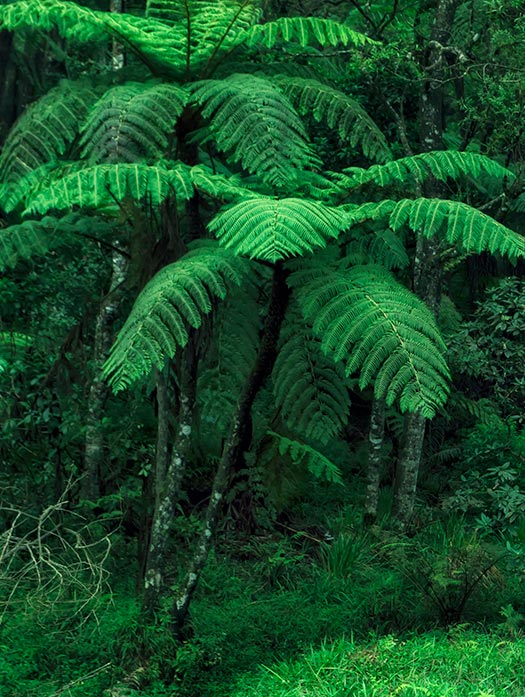
Tropical rainforests
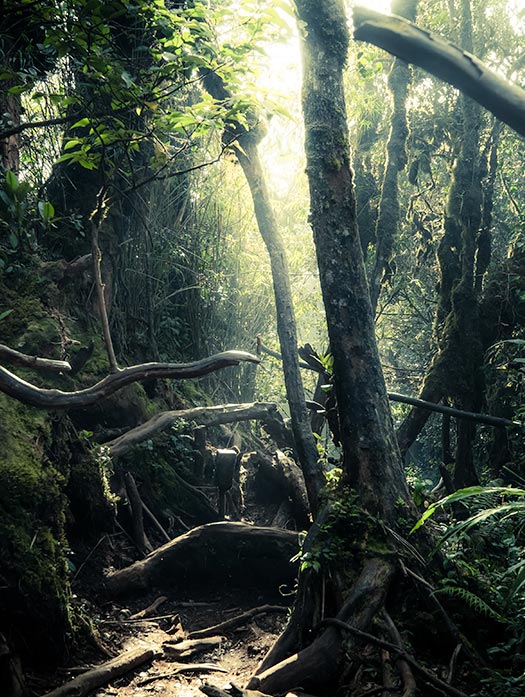
A tropical rainforest is a treasure trove of biodiversity and is absolutely bursting with life. It is constantly buzzing with the sounds from different animals -from the calls of birds at dawn, to the chatter of monkeys in the day, the intense hum of insects (like cicadas) at dusk, and sounds of frogs through the night. Vibrant greens of thousands of different plant species seem to cover every exposed surface around you. When you experience a rainforest for the first time, and maybe many times after that, it seems like there is always something new to look at, and realistically there is. Scientists are continually discovering and describing new species of plants, insects, birds and sometimes even mammals, because there are just so many of them! So what is a tropical rainforest and what makes it so that it can be so diverse?
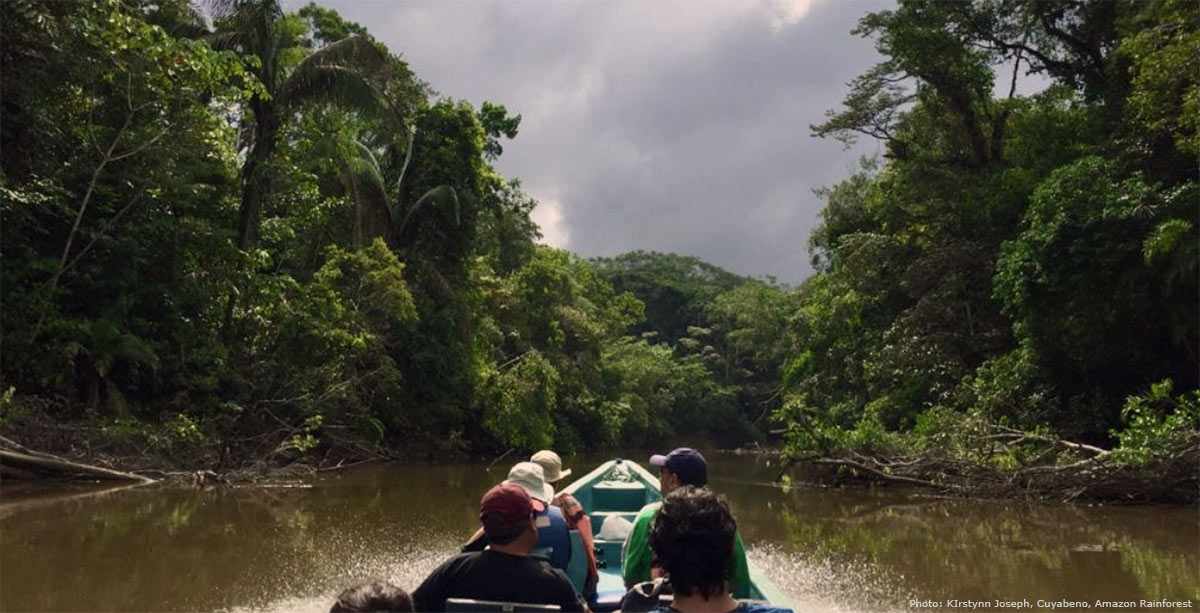
Where are tropical rainforests found?
Based on latitude lines, which are the imaginary lines that run east and west on our planet, we can divide the world into three regions: Polar, tropical, and temperate. Polar regions are the most northern and southern (between 66° and 90° lat) , with temperate regions further towards the equator (23° and 66° lat) and tropic regions in the center (between 0° and 23°) surrounding the equator line.
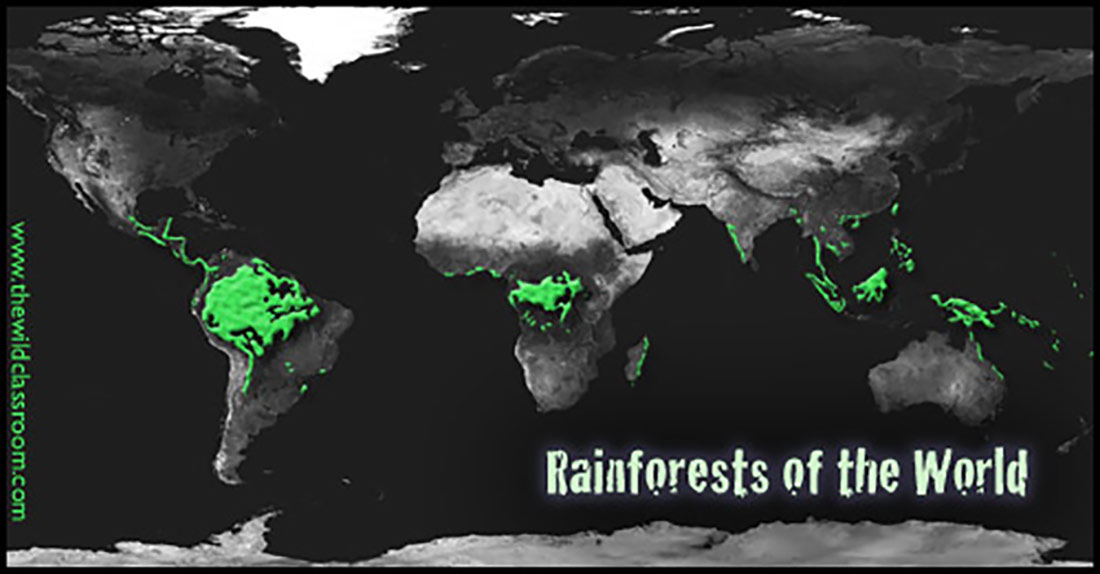
Tropical rainforests are located within, you guessed it, the tropical regions of our planet. Covering around 6-8% of terrestrial earth, we find tropical rainforests: in the southern region of Central America, Southeastern Mexico, Equatorial South America (and some of the east coast of Brazil), Equatorial Africa, Madagascar, Western India, Southeast Asia, Northeastern Australia and the Pacific Islands. The tropical rainforests can be grouped into three regions: Neotropical (South America and Central America), African (Africa and Madagascar), and Indo-Malaysian (India, Southeast Asia, Australia and the Pacific Islands). You can also see Active Wild for a breakdown of rainforest locations.
What defines a tropical rainforest?
Tropical rainforests are one of the oldest ecosystems on our planet, but what makes a tropical rainforest different from any other forest? When defining a biome, we are primarily interested in the abiotic factors, which are the nonliving characteristics such as precipitation (rain and snowfall). So what abiotic factors define a tropical rainforest?
Precipitation
How much does it rain in a tropical rainforest? Rainforests are generally defined by two factors: (1) there must be at least 1750-2000 mm (69-78 inches) of rain per year (2) this rain must be distributed throughout the year. This is important because there are different biomes that receive really high quantities of rain, but only for a short period of time in the year, and are otherwise dry and hot, which greatly inhibits plant growth. Essentially, lots of rain consistently throughout the year is key to maintaining the large amount of plant life that makes up a rainforest. Rainforests do still have a dry-season but this usually means less rain, not that the rain stops entirely.
As well as being very rainy, rainforests are also humid. Humidity refers to the moisture in the air, or the amount of water vapour found in the air, and it is very high in rainforests (around 80%). This humidity is the result of high precipitation, the huge biomass (the amount or mass of living tissue in an area) of plants, and the heat. Why? Because of evapotranspiration, which is the combined evaporation of water to gas and transpiration, which is the release of water out of the leaves of plants that occurs during photosynthesis. Funny enough, the humidity is both a result of the large amount of plant life, and one reason for the high biodiversity. Additionally, this high level of evapotranspiration helps to produce rain for the rainforest itself, because the water evaporates up, condenses in the cooler air above, and falls again as rain.
Temperature
How warm is the rainforest? Rainforests are characterized by continually warm temperatures – between 20-35°C (68-95 °F) year round. This steady temperature. with such minor change through the seasons, allows for a lot of organisms to do really well, without the need to migrate or hibernate at any time of year.
Soil nutrients
Interestingly enough, rainforests contain some of the most nutrient-poor soils (they have very little nutrients) of all the biomes. The continual rainflow washes many of the nutrients away, while at the same time the nutrients that do reach the soil are quickly taken up by the abundant plant life. Though there is lots of litter (fallen leaves, trees, and other dead material) that should help add to soil nutrients, it is quickly decomposed by the heat, moisture, and decomposing organisms such as insects, then the plants use those nutrients as quickly as they can, leaving very little in the soil itself.
Sunlight hours
Being located in the area around the equator has another advantage for life: consistent and direct sunlight all year long. This means that plants have good access to light year-round unlike many biomes in the north and south that experience short winter days. However, the gigantic trees that dominate the majority of tropical rainforests do not allow much of that light to reach further down in the forest (see below).
Layers in the Tropical Rainforest
The great diversity in the rainforest creates interesting layers, in which different plants and animals live. Some organisms can survive in different layers, or use different layers for different activities, while some stay in a certain layer their whole lives. As you will see, the amount of light available is really important in determining what we find in each layer, as it is so important for photosynthesis and the different interactions between plants and animals and between different animals.
So what are the layers of a tropical rainforest? Though these layers can not be precisely in real life, and are still all dependent on each other, we consider the tropical rainforest to have six layers: subterranean, forest floor, shrub layer, canopy and emergent layer.
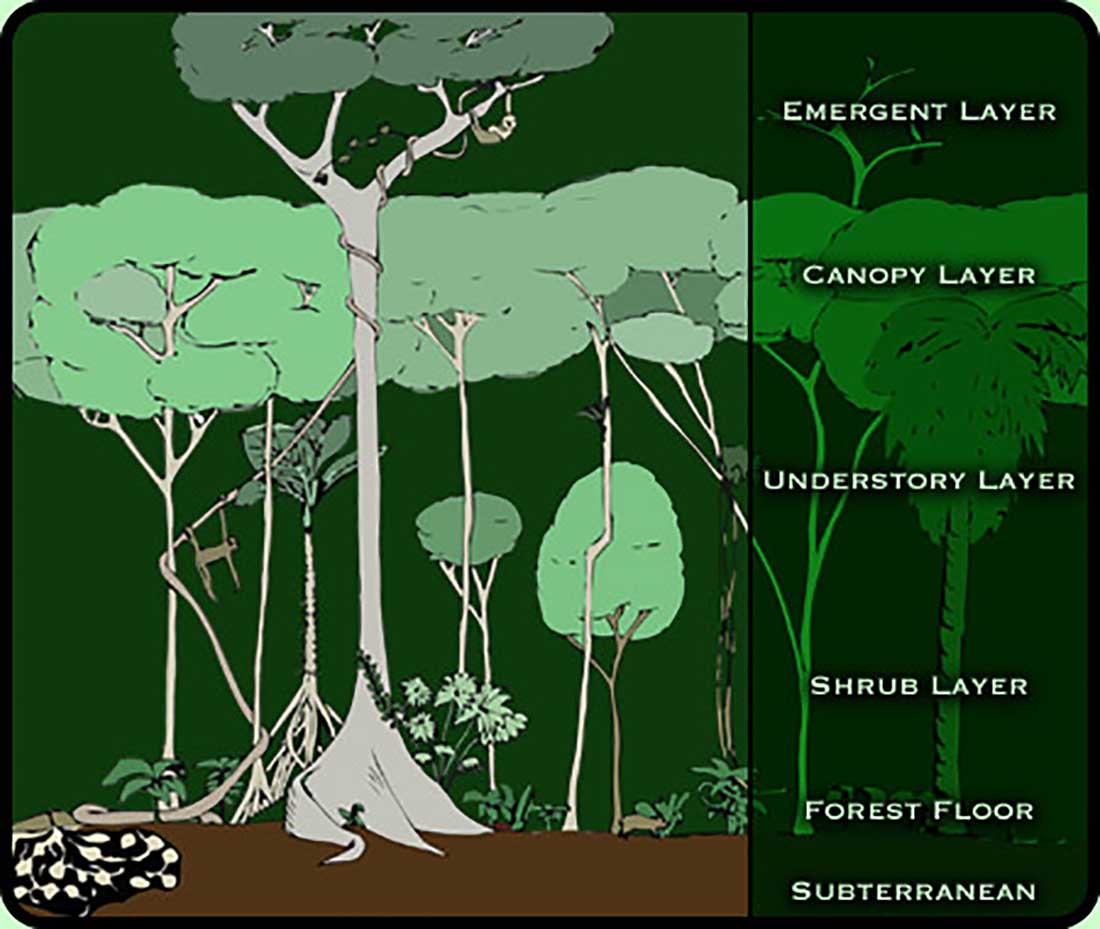
Subterranean
This is the layer underneath the soil. Since we can’t see it, we often underestimate the activity that occurs here. Though rainforests are nutrient-poor they still contain lots of life, from fungi to different types of insects. For example, there are some ants in the Amazon Rainforest that are almost completely subterranean and because of this have extremely tiny eyes, or no eyes at all. These ants, such as the Martialis heureka or various ants from the genus Prionopelta, spend most of their life in the dark, hunting other small underground invertebrates.
Forest Floor
Just as it sounds, this is the base of the rainforest. Very little light (1-2%) reaches this part of the rainforest because of all the other trees and shrubs above it. Due to this, plant life here is restricted to those who survive with almost no light, that are shade-tolerant, such as a variety of ferns or Elephant Ear plants. However, sometimes, a large tree will fall, allowing sunlight to penetrate to this layer, and give a chance to other plants to grow in this new found light. This is called gap dynamics.
Shrub Layer
Little light also reaches this layer, as it is still below the main canopy. Due to this, trees and shrubs do not manage to grow very tall, and must also grow broad leaves to gather as much light as they can. As well, little wind travels here and humidity is very high. This area contains a lot of different animals as well. For example, many reptiles, like the Reticulated Python, live between here and the forest floor, taking advantage of the warm damp conditions. Many insectivorous birds (the birds that eat insects) like the various species of babblers, also live here, as lots of insects are found in this area or on the forest floor.
Canopy
This is the part of the forest where the tops of most trees can be seen, forming a thick (around 6 meters or 19 feet) rooflike sea of green that shades the rest of the forest. Since there is light here, there is a huge bounty of leaves, flowers, and fruit to eat, which make this the most populated part of the forest. Everything from monkeys to snakes and some frogs, like the Red-eyed Tree Frog, and fruit eating birds, such as the colorful toucan, live here. Many animals will stay up here their whole lives, as it holds all the food they need and water can either be found trapped in leaves or parts of branches, or found within the fruits that they eat.
Emergent Layer
In this layer, the tallest trees stick out of the canopy, these are the biggest trees, reaching heights over 60 meters (196 ft) tall. They usually have thinner waxy leaves because they are much more exposed. These trees have few branches and leaves but spread out very widely. This layer is less occupied than the canopy, but still offers a great home for monkeys and butterflies enjoying the flowers and fruits growing here, and of course the birds of prey, such as the Harpy Eagle of South America, that soars above searching for prey.
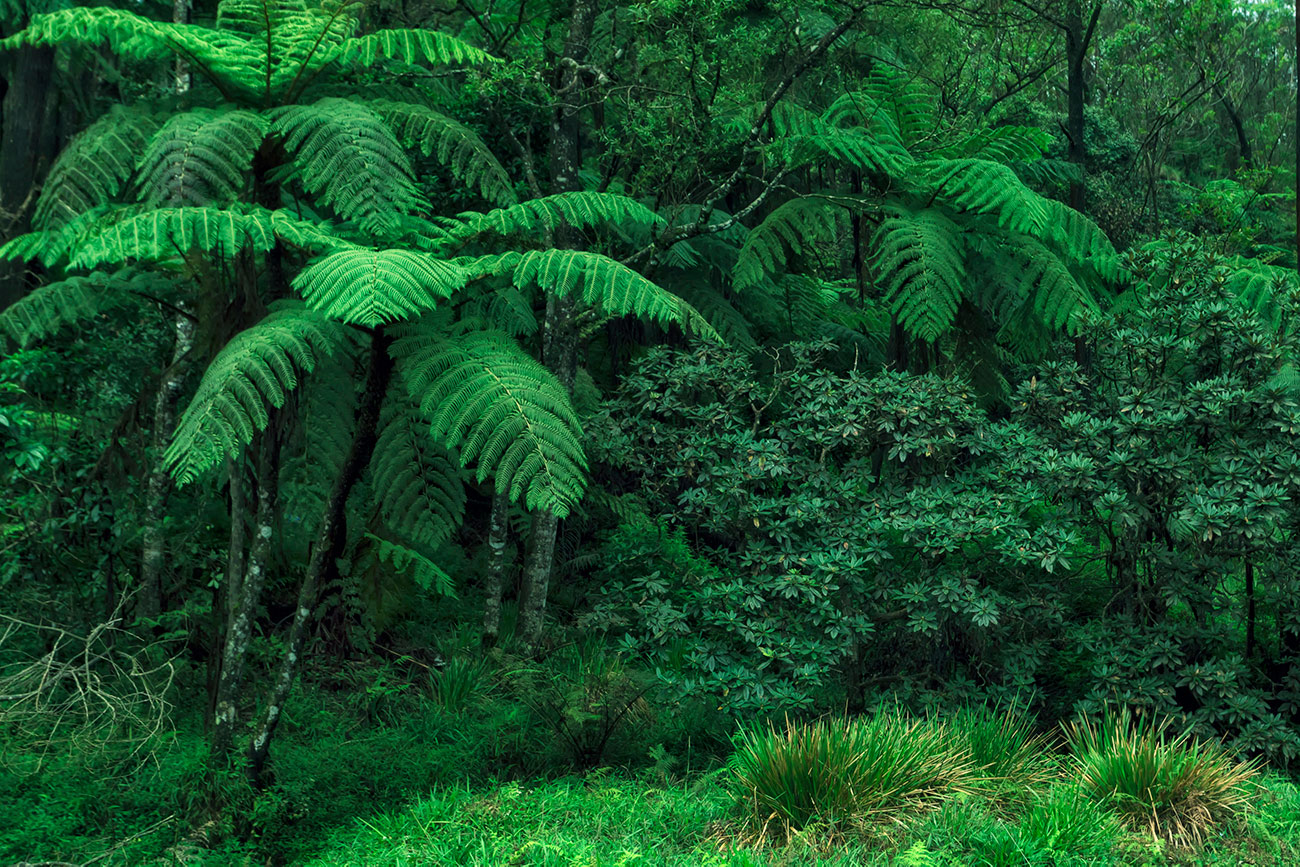
Biodiversity
Tropical Rainforests hold the greatest diversity of life, in terms of both plants and animals, containing more than half of all species in the world. The conditions here enable an incredible range of organisms to thrive, creating a dizzying amount of variation. So, what animals and plants are adapted to the tropical rainforest?
Plants of the Rainforest and their Adaptations
Plants of the rainforest are specially adapted to the conditions that exist here.. For example, plants here do not have to deal with the harsh seasonality of a temperate deciduous forest biome and they have a consistent supply of rain, however, they do need to cope with high heat and evapotranspiration, as well as low soil nutrients and many do not receive much light below the canopy.
A rainforest is dominated by trees. The lack of nutrients deep in the soil means that to stay stable, these trees, instead of having deep roots, spread their roots out over great distances on the forest floor and have strut-like structures called buttresses to help stabilize them as well as absorb nutrients from the upper soil and leaf litter around them. They also tend to have thinner waxy bark, as they do not need to protect against the cold, like in many other biomes. As well, trees in the canopy have waxy leaves and drip-spouts to repel water and avoid becoming moldy in the high humidity. Another notable struggle for many of these trees is the lack of wind to spread their seeds; To deal with this, many trees produce delicious fruits so that animals will eat them and spread the seeds in their feces as they move around the forest.

Another interesting group of plants are the Epiphytes, which are plants that live on other plants. Some of these plants actually never touch the ground! Additionally, tropical rainforests are home to hemi-epiphytes, like figs, which start up high in the canopy and release their roots down to the ground! (seems a bit upside down doesn’t it?).

Tropical rainforests are also home to the most diverse flowers in the world, orchids. With between 20-30,000 naturally occurring species, orchids are specially adapted to live in darker moist areas with little air movement. Under these circumstances, they attract pollinators, meaning animals that eat their nectar and help them to reproduce by spreading pollen, by having a very strong and lovely scent that can help them to be found during the day or at night.
Animals of the rainforest
Since there are so many animals in the rainforest, it is important that an organism has a specific niche (meaning where they live, what they eat, and how they interact with other organisms). With such a high diversity of life, there are organisms that live in the different layers of the rainforest, or are active during different times of the day. This limits direct competition with other species that also exist in the forest.
There is a huge variety to choose from but here are some interesting examples:
Many animals are Diurnal, or awake during the day, and use the light to their advantage. Primates, such as orangutans from Borneo, are frugivores (fruit eaters) and can actually use color-vision to help them find fruits, and to be able to tell if they are ripe or not. However, their vision is not very good at night, so they must be wary of predators once the sun goes down.
The rainforest also has many animals that are nocturnal, or active at night. Bats are a highly diverse inhabitant of the rainforest, and are very important for insect control and pollination, depending on whether they eat insects or fruits and nectar. Megabats, which are all bats that eat fruits and the nectar from flowers (just like a bee) serve a key role for night time pollination in the rainforest. They do not see very well, so they use echolocation, making sounds and listening for the echo to tell the size and distance of objects, to help them find their way around the rainforest at night.
The tropical rainforest is also home to a wide range of animals that are poisonous, harmful if eaten or sometimes even touched, and venomous, harmful if they bite or sting you. Many rainforests host toxic frogs that could kill you on touch, for example the golden dart frog which is endemic to Colombia has enough toxin to kill 10 adults. They are brightly colored to warn predators of this danger and are therefore protected from predation.
Such a wide variety of animals means there are a lot of predators, which makes camouflage (blending into your environment) and mimicry (trying to look like a different organism – usually one that is more dangerous than you are) important adaptations for many animals. However these are also useful to the hunters themselves! The Jaguar is camouflaged by its spots in the patchy sunlight that barely reaches the forest floor and the vegetation around it. This helps it to sneak up on its prey. Mimicry is well represented by the Asian Ant Mantis, that looks almost exactly like an ant, and uses this to get close to its prey (the ants) and launch a sneak attack.
Even the waters that run through the rainforests are full of a diversity of animals. The muddy waters of the amazon for instance support diverse assemblages of fish including electric eels, pink dolphins, arapaima and piranha. Surprisingly, piranha are not as dangerous as most people think. They are even a great source of food for many people in the rainforest. Attacks by piranha are rare and can easily be avoided.
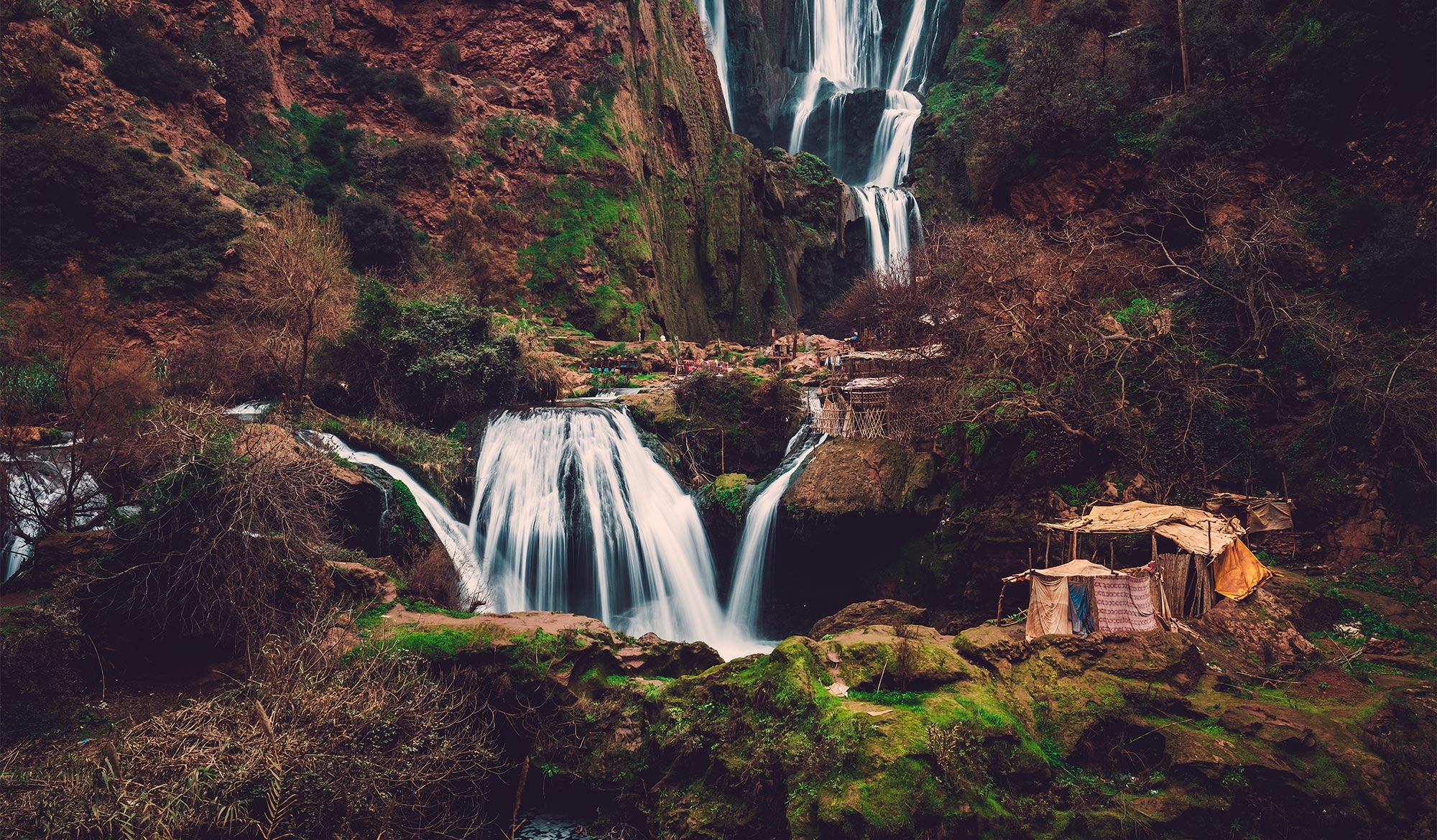
Types of Rainforest
First it is important to note that there are different types of “rainforest” that do not fall into the category of “tropical rainforest” but here we are focused on the tropics. So, what are the different types of tropical rainforest?
The tropical rainforest you are probably most familiar with, and the one we have described up until now are lowland evergreen rain forests, which have very similar rains all year and the highest diversity, or Semi-evergreen rain forests, which have an annual period of drought, lower diversity, and a higher mixing of evergreen trees (trees that never lose their leaves) and deciduous trees (trees that annually drop their leaves to conserve energy during harsher seasons).
Montane rainforests (or cloud forests), mangrove forests, and monsoon forests can also be considered tropical rainforests but are quite different.
Montane forests grow in higher altitude creating shorter trees and different vegetation and are usually a bit cooler. As well, they have less vine plants and the trees tend to not have the buttresses seen in lowland evergreen and semi-evergreen forests.
Mangrove forests grow along rivers that meet the ocean, have much less distinct layering, and little to no forest floor as the roots are often under water. These trees, such as the Red Mangrove, are highly specialized to survive drastic change and live in brackish water, meaning it is a mix of salt and freshwater.
Lastly, monsoon forests experience heavy rainfalls (or monsoons) followed by longer periods of drought which creates more difficult growing conditions and leads to much lower diversity and more deciduous trees.
Even within a similar forest type, let’s discuss lowland evergreen and semi-evergreen tropical rainforests, there are distinct differences in the species of plants and animals located there.
Diversity of species is highest in the Neotropical rainforest, followed by Indo-Malaysian, and lastly African. Rainforests are quite far apart, and because of this there are a lot of differences between the species that inhabit them. For example, African elephants live in African rainforests, while Indian elephants (a different species) inhabit some Indo-Malaysian rainforests, and no elephants are found in the Neotropics. As well, in many rainforests, there is a large number of endemic species, meaning you can only find them in one place in the world. In the rainforests of Eastern Madagascar, that are home to a variety of lemurs, lives the unique and adorably strange aye-aye and other lemurs, that are found nowhere else on earth. Plants of rainforests also vary between these different regions, but the list is endless.
Rainforests and us
The tropical rainforest is extremely important. It holds our greatest diversity – which makes it an amazing ecotourism destination, it produces an incredible amount of oxygen, stores carbon in all of its living plants, and is home to many important edible and medicinal plants that we use every day, like the Curare vine which is used as a muscle relaxant and anesthetic for surgery. In addition to this, many important organisms that live in rainforests help us in our human systems. For example, parasitic wasps that feed on insects that destroy the crops that we farm (plague insects), can expand out from a healthy rainforest and help us with pest control. Last but not least, many indigenous peoples call the rainforest home, and destroying the rainforest takes away their way of life.
Unfortunately, every day more and more rainforest is cut down for development and agriculture, many times without replanting measures. This not only threatens the many endangered species of these forests, but it also means we lose all the amazing benefits that the rainforest provides us with, and the people living in the rainforest must move to smaller and smaller areas or change their way of life. For these reasons, it is so important to help conserve and rehabilitate our tropical rainforests.
Fortunately, there are lots of programs out there to help the rainforest, and many governments are moving to protect them, but it is a battle that we must continue to fight, to ensure our rainforests are here for generations to come.
Article by Kirstynn Joseph (follow her on twitter)
A short video about the rainforest biome
Here is a video we shot in 2007 while studying rainforests in Panama.
The Rainforest in 360 Degrees!
Did you enjoy that 360° experience? If so, watch more.

